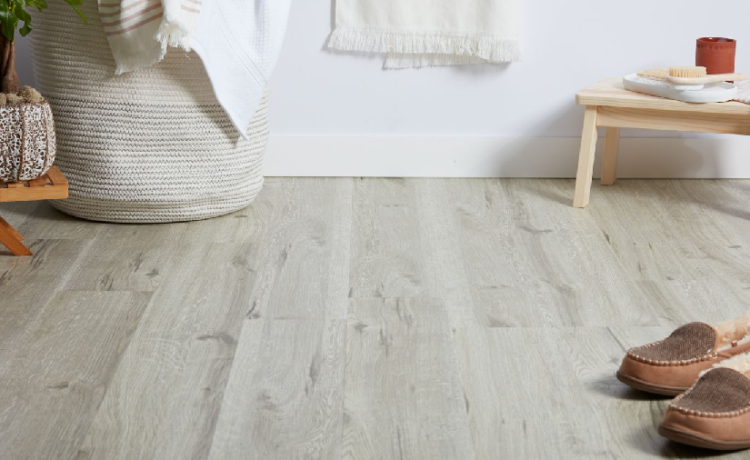Unlike what happens in comparison with laminates, vinyl flooring and porcelain tile have very evident visual differences, making it a little easier for consumers to identify these types of flooring.
Despite this apparent ease in identifying them, many still feel insecure in defining which of these two options would be the most accurate.
Vinyl or porcelain floor: what are they made of?
The first and most apparent difference between vinyl and porcelain floors is in the composition. Knowing what goes into your ‘recipe’ makes us better understand the structure of these floors since they are characteristics that influence various aspects, such as acoustics, comfort, and practicality in cleaning, among others.
Porcelain tile is developed from a mixture of clays, minerals and colourants, whose burning of the mass in gas ovens guarantees a compact and rigid base piece, in addition to forming a glazed surface with a wide variety of standards and colours in high definition.
Vinyl flooring, on the other hand, is made of PVC, mineral fillers, plasticisers, pigments, and additives, forming light and flexible structures. If you have already heard of it as a ‘rubber floor’, you should know that, despite its flexibility, there is no rubber in its composition.
Vinyl or porcelain floor: how are they installed?
Vinyl flooring: installation with quick-drying adhesive
The building is another point that differs a lot between vinyl and porcelain floors. Understanding these differences helps to assess which option best satisfies the relationship between availability and need for time and resources, which naturally can vary significantly from project to project.
Porcelain tile is installed by laying the tiles, which must be done on the level subfloor using grout. After this process, it is necessary to wait at least 72 hours to start the grouting stage, which also requires another three days to dry. When buying porcelain tile, it is essential not to forget the losses and buy 10 to 15% more material to compensate for what is lost due to breaks in the cutting of the tiles.
The vinyl floor now has a practical and clean installation: the curing time is much shorter, and there is no need to break it since it can be applied on other existing floors, such as cement, ceramic and porcelain, with joints of up to 5 mm, provided they are prepared and levelled with self-levelling compound. For conventional pagination with tiles and tables, the extra margin to compensate for losses is usually 5%.
Tile, plank and sheet vinyl flooring are installed using a specific adhesive.
Remember: Regardless of the material chosen, the installation must be done by trained professionals, preferably experienced with the chosen cladding, for a well-planned and executed installation with a flawless finish.
Vinyl or porcelain floor: what are the indications for use?
The type and use of each environment greatly influence the choice of cladding to be installed since the benefits provided by these materials can be enhanced according to the chosen space.
Inside the house, the search for sensations of comfort and welcome are gaining more and more prominence. Vinyl flooring is unbeatable because it goes beyond the ‘warm’ aspect of wood: it provides a tactile experience, thermal comfort and acoustic performance superior to those of porcelain and other cold floors.
These benefits give vinyl flooring a good advantage over porcelain tile in most internal environments, such as bedrooms, kitchens, living rooms and bathrooms. On the other hand, vinyl flooring cannot be installed in bathrooms with showers and in outdoor areas due to the abundant and frequent presence of humidity and the action of the elements.
If the search is for a floor that can be used in wet areas, internal or external, such as patios, laundry rooms and bathrooms with showers, porcelain tile is the best option. It is enough to verify if the chosen model has a good specification for that use.
Vinyl or porcelain floor: which is easier to clean?
Vinyl floor cleaning is quick and easy.
Practicality in cleaning is a determining factor for more pleasant day-to-day since less time spent on this task leaves more time for others. Both porcelain and vinyl flooring are relatively easy to clean, but differences in procedures can save you money.
To clean the vinyl floor, use a cloth or mop with neutral detergent diluted in water – you can see the step-by-step and what not to do when cleaning this floor here. This makes vinyl flooring a coating that requires a relatively small amount of water and other products to keep it clean and beautiful.
Due to the technologies applied to the surface of vinyl flooring, making it less porous and the absence of apparent grouts, vinyl flooring is a little easier to clean daily than porcelain tile.
In porcelain tile, neutral detergent diluted in water is also the most common formula for daily cleaning, but products such as disinfectants, sanitary water and even vinegar are also applied.
A habit commonly associated with cold floors is washing water from the hose or in buckets, which can even be interesting on the bottoms of external areas due to their large dimensions. Still, it does not need to be frequent in internal environments because A well-done daily cleaning eliminates this unnecessary water consumption.
Except for embedded models, all vinyl floors can be washed as long as there is no standing water after cleaning. Another tip is not to use abrasive or petroleum-based products, which cause a chemical reaction that permanently damages the floor.
Vinyl or porcelain tile: which is the best?
Between vinyl or porcelain flooring, the best will be the one that satisfies the taste and needs of each environment, adding the most significant number of benefits. In general, vinyl flooring has more benefits than ceramics, stones and laminates, as you can compare in the following table:
Despite this, even within each type of flooring, there are sub-categories to broaden the range of where the material can be used. Among vinyl floors, for example, there are differences between models, formats, textures, standards and colours that can perform better in some projects and environments than in others.
The secret is to combine different solutions of these coatings to find the balance. For this, never hesitate to seek professionals such as architects and interior designers for accurate specifications.











